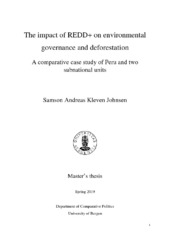| dc.description.abstract | Peru adopted a “nested approach” to REDD+ in 2008. The nested approach can teach us a lot about environmental governance and deforestation, because Peru develops REDD+ the on local, regional and national level. The international REDD+ society regard the national approach as more effective for reducing deforestation because it can build capacity and promote policies on the national level. On the other hand, scholars of community based-natural resource management (CBNRM) argue that decentralization and community management are key for managing natural resources. In this thesis I examine the research question: “How does climate aid through REDD+ affect existing environmental governance and deforestation in Peru?”. In a before-after study of REDD+ in Peru, I examine the effect of REDD+ on Peru and the regions San Martin and Loreto. Fieldwork and interviews have been fruitful for collecting data, and first-hand information from Peru gives me in depth knowledge on how REDD+ affects environmental governance and deforestation in Peru. Institutional stability is key for managing natural resources, but developing countries face many institutional, economic and social challenges against establishing successful environmental governance. I discuss the obstacles and opportunities REDD+ has for advancing environmental governance in Peru. In addition, my theoretical framework is based on the idea that community-based natural resource management (CBNRM) is preferable for keeping deforestation low, and community ownership through titling of indigenous communities is crucial for achieving this in Peru. I find that REDD+ has contributed with increased concern and funding towards environmental issues in Peru. REDD+ has promoted titling of indigenous communities, and my findings indicate that titled indigenous communities in Peru have low deforestation compared to other areas. Nonetheless, CBNRM does not hold for San Martin, where some indigenous people deforest a lot, in the context of much migration, illegal activities and infrastructure. The findings regarding deforestation in Loreto are inconsistent, and different methodologies for measuring deforestation result in different deforestation rates. Nevertheless, indigenous communities in Loreto generally have low deforestation rates, in line with CBNRM. REDD+ needs to improve horizontal linkages outside the Ministry of the Environment and solve conflict over land in order to hinder deforestation in the future. | en_US |
